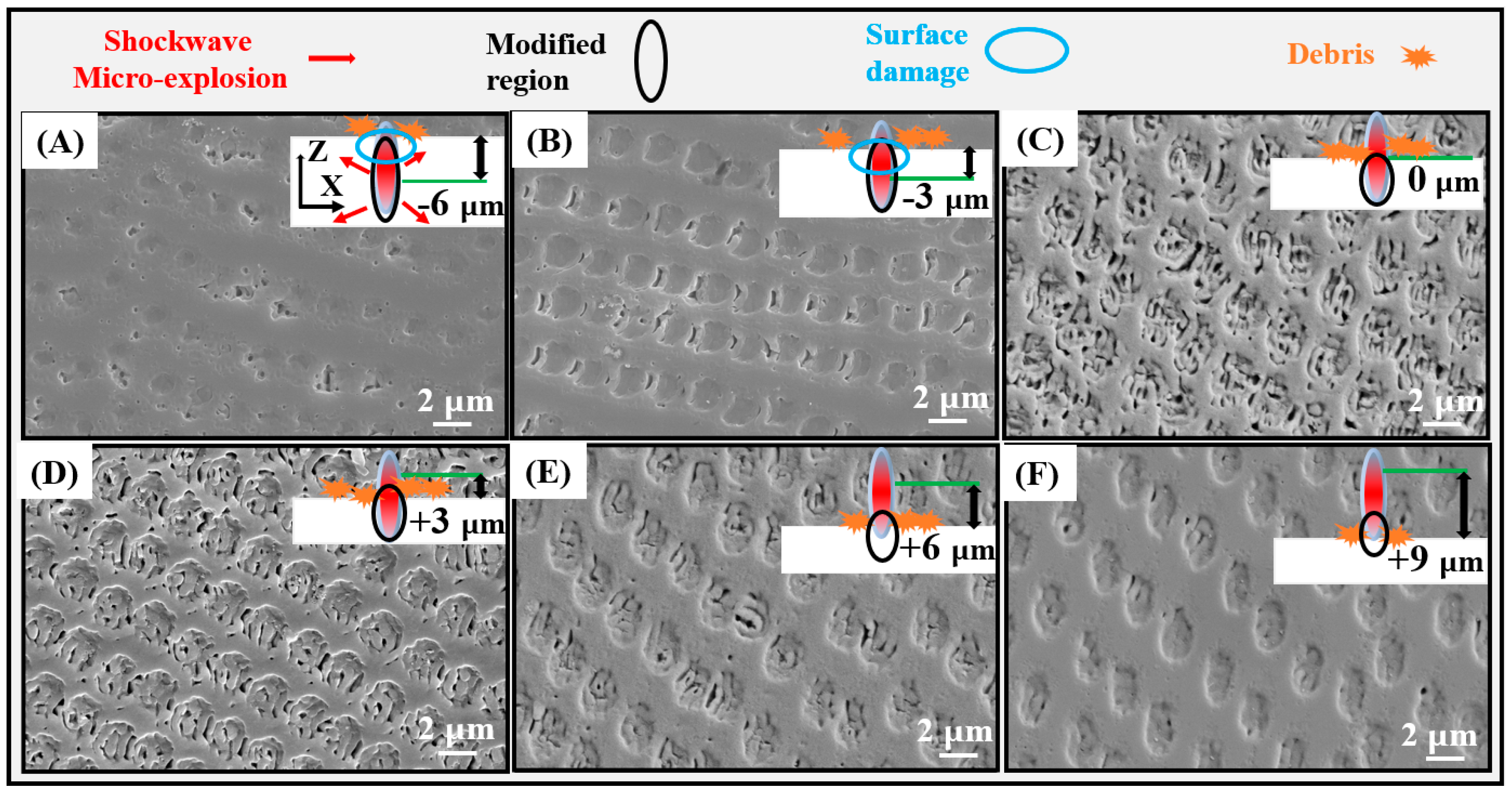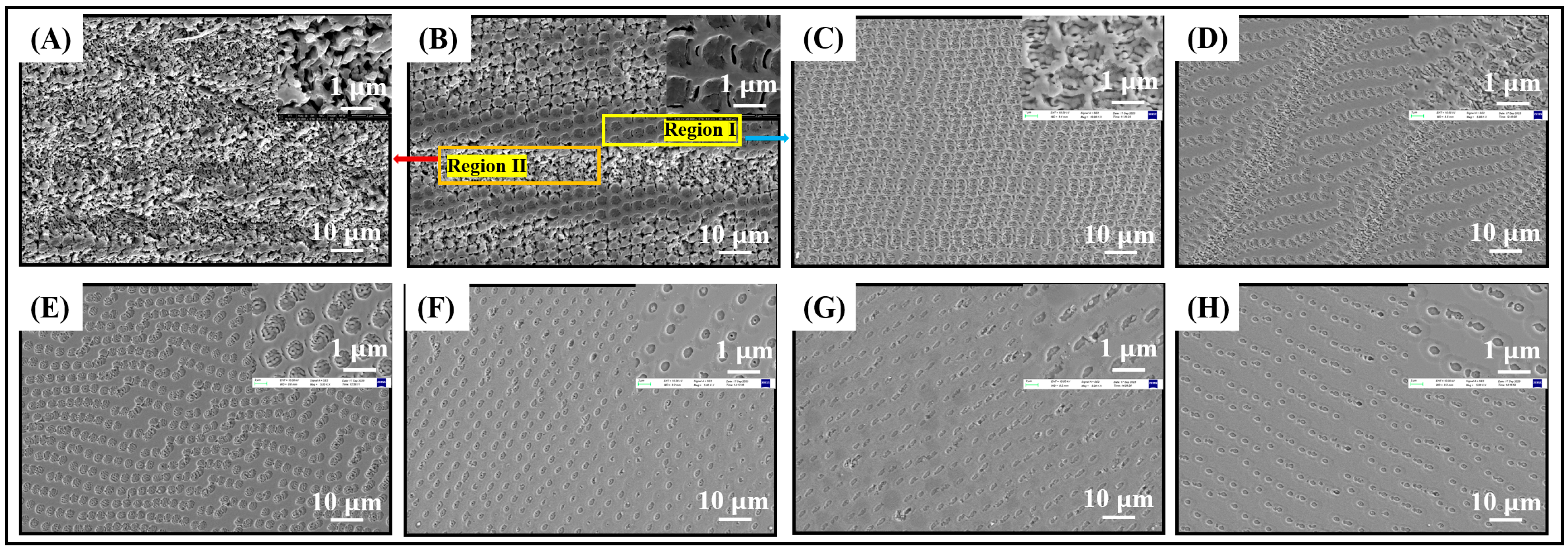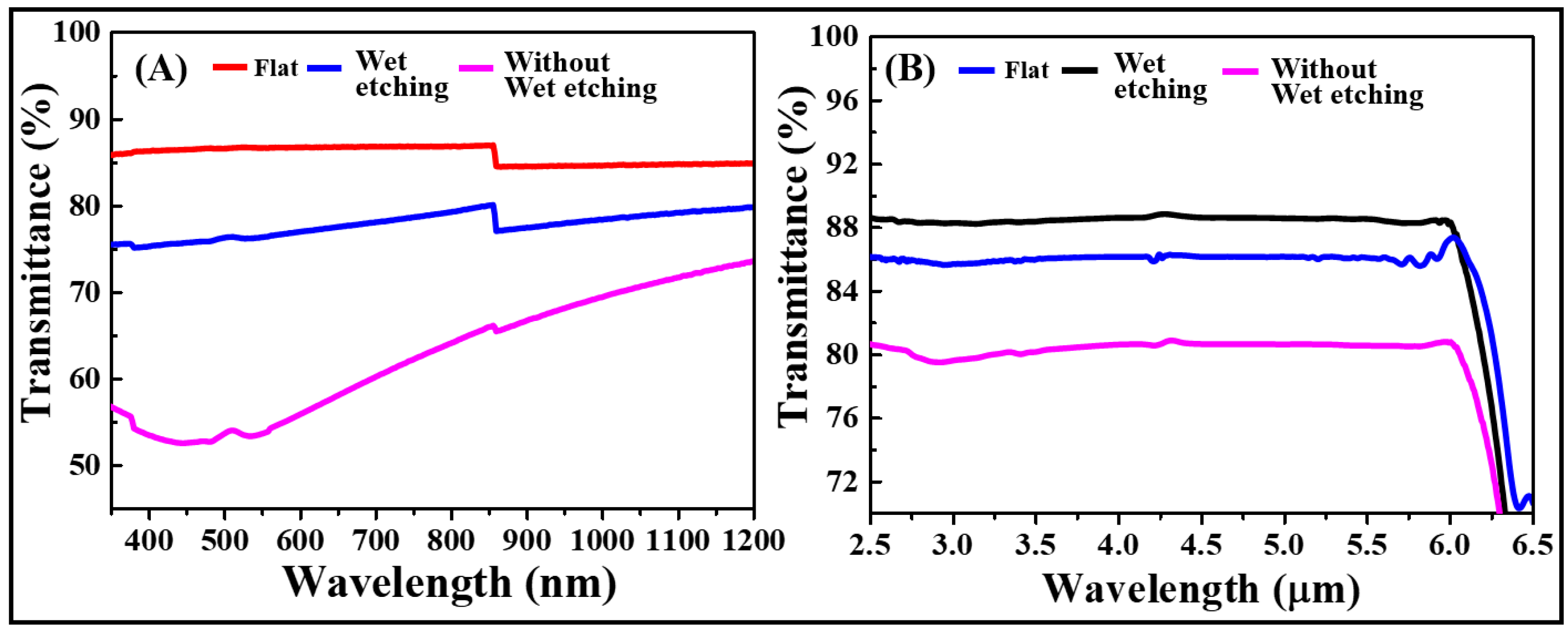A Method for Preparing Surface Sub-Microstructures on Sapphire Surfaces Using Femtosecond Laser Processing Technology
Abstract
:1. Introduction
2. Experimental Section
3. Results and Discussion
3.1. Effect of the Distance Out-of-Focus of the Femtosecond Laser Beam Spot on the Sub-Microstructures
3.2. Effects of Scanning Speed and Space on Sub-Microstructures
3.3. The Wettability and Optical Properties
4. Conclusions
Supplementary Materials
Author Contributions
Funding
Institutional Review Board Statement
Informed Consent Statement
Data Availability Statement
Conflicts of Interest
References
- Liu, X.-Q.; Bai, B.-F.; Chen, Q.-D.; Sun, H.-B. Etching-Assisted Femtosecond Laser Modification of Hard Materials. Opto-Electron. Adv. 2019, 2, 190021. [Google Scholar] [CrossRef]
- Hernandez-Rueda, J.; Götte, N.; Siegel, J.; Soccio, M.; Zielinski, B.; Sarpe, C.; Wollenhaupt, M.; Ezquerra, T.A.; Baumert, T.; Solis, J. Nanofabrication of Tailored Surface Structures in Dielectrics Using Temporally Shaped Femtosecond-Laser Pulses. ACS Appl. Mater. Interfaces 2015, 7, 6613–6619. [Google Scholar] [CrossRef]
- Han, S.; Kim, H.; Kim, Y.W.; Kim, Y.-J.; Kim, S.; Park, I.-Y.; Kim, S.-W. High-Harmonic Generation by Field Enhanced Femtosecond Pulses in Metal-Sapphire Nanostructure. Nat. Commun. 2016, 7, 13105. [Google Scholar] [CrossRef]
- Liu, X.; Yang, S.; Yu, L.; Chen, Q.; Zhang, Y.; Sun, H. Rapid Engraving of Artificial Compound Eyes from Curved Sapphire Substrate. Adv. Funct. Mater. 2019, 29, 1900037. [Google Scholar] [CrossRef]
- Liu, H.; Li, Y.; Lin, W.; Hong, M. High-Aspect-Ratio Crack-Free Microstructures Fabrication on Sapphire by Femtosecond Laser Ablation. Opt. Laser Technol. 2020, 132, 106472. [Google Scholar] [CrossRef]
- Butkutė, A.; Sirutkaitis, R.; Gailevičius, D.; Paipulas, D.; Sirutkaitis, V. Sapphire Selective Laser Etching Dependence on Radiation Wavelength and Etchant. Micromachines 2022, 14, 7. [Google Scholar] [CrossRef]
- Ren, N.; Xia, K.; Yang, H.; Gao, F.; Song, S. Water-Assisted Femtosecond Laser Drilling of Alumina Ceramics. Ceram. Int. 2021, 47, 11465–11473. [Google Scholar] [CrossRef]
- Liu, M.; Hu, Y.; Sun, X.; Wang, C.; Zhou, J.; Dong, X.; Yin, K.; Chu, D.; Duan, J. Chemical Etching Mechanism and Properties of Microstructures in Sapphire Modified by Femtosecond Laser. Appl. Phys. A 2017, 123, 99. [Google Scholar] [CrossRef]
- Cao, X.-W.; Lu, Y.-M.; Fan, H.; Xia, H.; Zhang, L.; Zhang, Y.-L. Wet-Etching-Assisted Femtosecond Laser Holographic Processing of a Sapphire Concave Microlens Array. Appl. Opt. 2018, 57, 9604. [Google Scholar] [CrossRef]
- Wen, Q.; Zhang, P.; Cheng, G.; Jiang, F.; Lu, X. Crystalline Orientation Effects on Material Removal of Sapphire by Femtosecond Laser Irradiation. Ceram. Int. 2019, 45, 23501–23508. [Google Scholar] [CrossRef]
- Li, Q.-K.; Cao, J.-J.; Yu, Y.-H.; Wang, L.; Sun, Y.-L.; Chen, Q.-D.; Sun, H.-B. Fabrication of an Anti-Reflective Microstructure on Sapphire by Femtosecond Laser Direct Writing. Opt. Lett. 2017, 42, 543. [Google Scholar] [CrossRef] [PubMed]
- Takaku, R.; Hanany, S.; Imada, H.; Ishino, H.; Katayama, N.; Komatsu, K.; Konishi, K.; Kuwata-Gonokami, M.; Matsumura, T.; Mitsuda, K.; et al. Broadband, Millimeter-Wave Anti-Reflective Structures on Sapphire Ablated with Femto-Second Laser. J. Appl. Phys. 2020, 128, 225302. [Google Scholar] [CrossRef]
- Liu, T.; Wei, H.; Li, J.; Lu, J.; Lin, Q.; Zhang, Y. Wettability Control of Sapphire by Surface Texturing in Combination with Femtosecond Laser Irradiation and Chemical Etching. ChemistrySelect 2020, 5, 9555–9562. [Google Scholar] [CrossRef]
- Xie, H.; Joshya, R.S.; Yang, J.; Guo, C. Controllable Fabrication of Polygonal Micro and Nanostructures on Sapphire Surfaces by Chemical Etching after Femtosecond Laser Irradiation. Opt. Mater. Express 2019, 9, 2994. [Google Scholar] [CrossRef]
- Li, Q.-K.; Yu, Y.-H.; Wang, L.; Cao, X.-W.; Liu, X.-Q.; Sun, Y.-L.; Chen, Q.-D.; Duan, J.-A.; Sun, H.-B. Sapphire-Based Fresnel Zone Plate Fabricated by Femtosecond Laser Direct Writing and Wet Etching. IEEE Photonics Technol. Lett. 2016, 28, 1290–1293. [Google Scholar] [CrossRef]
- Leem, J.W.; Kim, Y.P.; Yu, J.S. Tunable Behavior of Reflectance Minima in Periodic Ge Submicron Grating Structures. J. Opt. Soc. Am. B 2012, 29, 357. [Google Scholar] [CrossRef]
- Liao, Y.; Shin, S.H.; Jin, Y.; Wang, Q.J.; Kim, M. Producing Microscale Ge Textures via Titanium Nitride- and Nickel-Assisted Chemical Etching with CMOS-Compatibility. Adv. Mater. Interfaces 2021, 8, 2100937. [Google Scholar] [CrossRef]
- Liao, Y.; Son, B.; Zhao, Z.-J.; Jeong, J.-H.; Tan, C.S.; Kim, M. A Highly Ordered and Damage-Free Ge Inverted Pyramid Array Structure for Broadband Antireflection in the Mid-Infrared. J. Mater. Chem. C 2021, 9, 9884–9891. [Google Scholar] [CrossRef]
- Ahmmed, K.; Grambow, C.; Kietzig, A.-M. Fabrication of Micro/Nano Structures on Metals by Femtosecond Laser Micromachining. Micromachines 2014, 5, 1219–1253. [Google Scholar] [CrossRef]
- Zhigunov, D.M.; Evlyukhin, A.B.; Shalin, A.S.; Zywietz, U.; Chichkov, B.N. Femtosecond Laser Printing of Single Ge and SiGe Nanoparticles with Electric and Magnetic Optical Resonances. ACS Photonics 2018, 5, 977–983. [Google Scholar] [CrossRef]
- Xu, X.; He, J.; He, J.; Xu, B.; Chen, R.; Wang, Y.; Yang, Y.; Wang, Y. Efficient Point-by-Point Bragg Grating Inscription in Sapphire Fiber Using Femtosecond Laser Filaments. Opt. Lett. 2021, 46, 2742. [Google Scholar] [CrossRef] [PubMed]
- Xu, X.; He, J.; Liao, C.; Yang, K.; Guo, K.; Li, C.; Zhang, Y.; Ouyang, Z.; Wang, Y. Sapphire Fiber Bragg Gratings Inscribed with a Femtosecond Laser Line-by-Line Scanning Technique. Opt. Lett. 2018, 43, 4562. [Google Scholar] [CrossRef] [PubMed]
- Xu, S.; Fan, H.; Li, Z.-Z.; Hua, J.-G.; Yu, Y.-H.; Wang, L.; Chen, Q.-D.; Sun, H.-B. Ultrafast Laser-Inscribed Nanogratings in Sapphire for Geometric Phase Elements. Opt. Lett. 2021, 46, 536. [Google Scholar] [CrossRef] [PubMed]
- Cheng, W.; Wang, Z.; Liu, X.; Cheng, Y.; Polynkin, P. Microexplosions in Bulk Sapphire Driven by Simultaneously Spatially and Temporally Focused Femtosecond Laser Beams. Opt. Lett. 2023, 48, 751. [Google Scholar] [CrossRef] [PubMed]
- Liu, X.-Q.; Yu, L.; Chen, Q.-D.; Cao, L.; Bai, B.-F.; Sun, H.-B. Sapphire Concave Microlens Arrays for High-Fluence Pulsed Laser Homogenization. IEEE Photonics Technol. Lett. 2019, 31, 1615–1618. [Google Scholar] [CrossRef]
- Bian, H.; Wei, Y.; Yang, Q.; Chen, F.; Zhang, F.; Du, G.; Yong, J.; Hou, X. Direct Fabrication of Compound-Eye Microlens Array on Curved Surfaces by a Facile Femtosecond Laser Enhanced Wet Etching Process. Appl. Phys. Lett. 2016, 109, 221109. [Google Scholar] [CrossRef]
- Shao, Z.; Wu, Y.; Wang, S.; Wang, Y.; Sun, Z.; Wang, W.; Liu, Z.; Liu, B. All-Sapphire Fiber-Optic Pressure Sensors for Extreme Harsh Environments. Opt. Express 2022, 30, 3665. [Google Scholar] [CrossRef] [PubMed]
- Hua, J.; Ren, H.; Huang, J.; Luan, M.; Chen, Q.; Juodkazis, S.; Sun, H. Laser-Induced Cavitation-Assisted True 3D Nano-Sculpturing of Hard Materials. Small 2023, 19, 2207968. [Google Scholar] [CrossRef] [PubMed]
- Gottumukkala, N.R.; Gupta, M.C. Laser Processing of Sapphire and Fabrication of Diffractive Optical Elements. Appl. Opt. 2022, 61, 2391. [Google Scholar] [CrossRef]
- Capuano, L.; Tiggelaar, R.M.; Berenschot, J.W.; Gardeniers, J.G.E.; Römer, G.R.B.E. Fabrication of Millimeter-Long Structures in Sapphire Using Femtosecond Infrared Laser Pulses and Selective Etching. Opt. Lasers Eng. 2020, 133, 106114. [Google Scholar] [CrossRef]
- Liu, X.-Q.; Zhang, Y.-L.; Li, Q.-K.; Zheng, J.-X.; Lu, Y.-M.; Juodkazis, S.; Chen, Q.-D.; Sun, H.-B. Biomimetic Sapphire Windows Enabled by Inside-out Femtosecond Laser Deep-Scribing. PhotoniX 2022, 3, 1. [Google Scholar] [CrossRef]
- Wen, Q.; Wang, H.; Cheng, G.; Jiang, F.; Lu, J.; Xu, X. Improvement of Ablation Capacity of Sapphire by Gold Film-Assisted Femtosecond Laser Processing. Opt. Lasers Eng. 2020, 128, 106007. [Google Scholar] [CrossRef]
- Lu, Y.-M.; Liu, X.-Q.; Zhu, L.; Chen, Q.-D.; Juodkazis, S.; Sun, H.-B. Vector Scanning Subtractive Manufacturing Technology for Laser Rapid Fabrication. Opt. Lett. 2021, 46, 1963. [Google Scholar] [CrossRef] [PubMed]
- Sun, X.-C.; Liu, X.-Q.; Sun, Z.-J.; Li, S.-X.; Zheng, J.-X.; Xia, H.; Wang, L. Wafer-Scale High Aspect-Ratio Sapphire Periodic Nanostructures Fabricated by Self-Modulated Femtosecond Laser Hybrid Technology. Opt. Express 2022, 30, 32244. [Google Scholar] [CrossRef] [PubMed]
- Shamir, A.; Ishaaya, A.A. Large Volume Ablation of Sapphire with Ultra-Short Laser Pulses. Appl. Surf. Sci. 2013, 270, 763–766. [Google Scholar] [CrossRef]
- Miyagawa, R.; Goto, K.; Eryu, O. Periodicity Control of Laser-Induced Periodic Nanostructures by Thin Deposition Layer on Sapphire Substrate. Appl. Phys. Express 2020, 13, 096503. [Google Scholar] [CrossRef]
- Hörstmann-Jungemann, M. 3D-Microstructuring of Sapphire Using Fs-Laser Irradiation and Selective Etching. J. Laser Micro/Nanoeng. 2010, 5, 145–149. [Google Scholar] [CrossRef]
- Juodkazis, S.; Nishimura, K.; Misawa, H.; Ebisui, T.; Waki, R.; Matsuo, S.; Okada, T. Control over the Crystalline State of Sapphire. Adv. Mater. 2006, 18, 1361–1364. [Google Scholar] [CrossRef]
- Gamaly, E.G.; Rapp, L.; Roppo, V.; Juodkazis, S.; Rode, A.V. Generation of High Energy Density by Fs-Laser-Induced Confined Microexplosion. New J. Phys. 2013, 15, 025018. [Google Scholar] [CrossRef]
- Borodaenko, Y.; Syubaev, S.; Gurbatov, S.; Zhizhchenko, A.; Porfirev, A.; Khonina, S.; Mitsai, E.; Gerasimenko, A.V.; Shevlyagin, A.; Modin, E.; et al. Deep Subwavelength Laser-Induced Periodic Surface Structures on Silicon as a Novel Multifunctional Biosensing Platform. ACS Appl. Mater. Interfaces 2021, 13, 54551–54560. [Google Scholar] [CrossRef]
- Gurevich, E.L.; Levy, Y.; Bulgakova, N.M. Three-Step Description of Single-Pulse Formation of Laser-Induced Periodic Surface Structures on Metals. Nanomaterials 2020, 10, 1836. [Google Scholar] [CrossRef] [PubMed]
- Huang, M.; Zhao, F.; Cheng, Y.; Xu, N.; Xu, Z. Origin of Laser-Induced Near-Subwavelength Ripples: Interference between Surface Plasmons and Incident Laser. ACS Nano 2009, 3, 4062–4070. [Google Scholar] [CrossRef] [PubMed]
- Raguin, D.H.; Morris, G.M. Antireflection Structured Surfaces for the Infrared Spectral Region. Appl. Opt. 1993, 32, 1154. [Google Scholar] [CrossRef] [PubMed]






Disclaimer/Publisher’s Note: The statements, opinions and data contained in all publications are solely those of the individual author(s) and contributor(s) and not of MDPI and/or the editor(s). MDPI and/or the editor(s) disclaim responsibility for any injury to people or property resulting from any ideas, methods, instructions or products referred to in the content. |
© 2024 by the authors. Licensee MDPI, Basel, Switzerland. This article is an open access article distributed under the terms and conditions of the Creative Commons Attribution (CC BY) license (https://creativecommons.org/licenses/by/4.0/).
Share and Cite
Wang, K.; Chen, J.; Zhang, Y.; Li, Q.; Tang, F.; Ye, X.; Zheng, W. A Method for Preparing Surface Sub-Microstructures on Sapphire Surfaces Using Femtosecond Laser Processing Technology. Coatings 2024, 14, 481. https://doi.org/10.3390/coatings14040481
Wang K, Chen J, Zhang Y, Li Q, Tang F, Ye X, Zheng W. A Method for Preparing Surface Sub-Microstructures on Sapphire Surfaces Using Femtosecond Laser Processing Technology. Coatings. 2024; 14(4):481. https://doi.org/10.3390/coatings14040481
Chicago/Turabian StyleWang, Kaixuan, Jun Chen, Yubin Zhang, Qingzhi Li, Feng Tang, Xin Ye, and Wanguo Zheng. 2024. "A Method for Preparing Surface Sub-Microstructures on Sapphire Surfaces Using Femtosecond Laser Processing Technology" Coatings 14, no. 4: 481. https://doi.org/10.3390/coatings14040481




